Growth through Research and Development - what does ... - Vinnova
Growth through Research and Development - what does ... - Vinnova
Growth through Research and Development - what does ... - Vinnova
You also want an ePaper? Increase the reach of your titles
YUMPU automatically turns print PDFs into web optimized ePapers that Google loves.
syllabuses to new fields that are in dem<strong>and</strong> in society at large. In such anenvironment, where the universities are endogenous <strong>and</strong> flexibleinstitutions, it is no great step for the researchers <strong>and</strong> their departments tocollaborate with companies in the commercialisation process. In the USA,the government has in the first instance tried to give the individualresearchers <strong>and</strong> the universities good regulatory frameworks <strong>and</strong> incentivesto create their own reward systems in connection with thecommercialisation of research results (Goldfarb <strong>and</strong> Henrekson, 2003).In Sweden, it is the university researchers themselves that own the results oftheir research <strong>through</strong> the so-called Teacher’s Exemption. Almost all of theuniversities are run by the Government <strong>and</strong> centralised in one way oranother. It is the Government that decides on the size of the universities <strong>and</strong>their budgets <strong>and</strong> appoints professors. The scope for wage setting is limited<strong>and</strong> the universities cannot therefore be seen as direct competitors. This hasseveral consequences for the dissemination of technology. The universitiesreceive no income from commercialised university inventions <strong>and</strong> thus haveno incentive to help the researchers with patenting, licensing contracts, legalmatters, networks or commercialisation. The researchers have to establishnetworks with companies themselves. However, as the universities find itdifficult to retain personnel that have established contacts with companies,due to the inflexible pay-setting system, they generally do not want theresearchers to work with commercialisation at all. The result is that theresearcher limit their external activities to consulting assignments <strong>and</strong> thosewho become more deeply involved often keep this secret (Etzkowitz et al.,2002). In Sweden, the government has attempted to facilitate the transfer ofknowledge from the universities to industry by setting up a number ofagencies (see section 5.7).According to Henrekson (2002), abolishing the Teacher’s Exemption inSweden <strong>and</strong> replacing it by making the universities or departments theowners of the research results would not necessarily lead to more inventionsfrom the universities being commercialised. The reason for this is that theSwedish Government-run universities – unlike the privately-run Americanuniversities – are neither run with a view to making a profit nor subject tocompetition. The result of abolishing the Teacher’s Exemption could be thatthe universities simply sit on the research results without any incentive topursue them commercially. In order to increase entrepreneurship amonguniversity researchers, Henrekson (2002) proposes instead that the linkbetween research successes <strong>and</strong> the allocation of resources by theGovernment should be strengthened, i.e. that the universities shouldcompete more for public funding (see section 6), <strong>and</strong> that more general29
















